|
Porsche 911 (964):
Enthusiast's Companion: 1989, 1990, 1991, 1992, 1993, 1994
Price: $89.95
|
©2002 Robert Bentley, Inc. We encourage visitors to link to this page if you’d like to share this information with others. Please do not copy this excerpt to other web sites. It is protected by copyright and represents significant resource investment by Bentley Publishers.
(4 page excerpt from Chapter 3)
Lubrication system
Oils
As of year 2000, the oils approved for use in all Porsche engines for model years 1973 to 2000 are listed below.
| Approved engine oils | ||
| ||
| ||
| ||
| ||
| ||
| ||
CAUTION — |
Oil system
The components of the normally aspirated engine lubrication system are:

As with all previous 911 series engines, the M64 and M30 engines are dry-sumped. The oil is stored externally in an oil tank, located forward of the right rear wheel in the wheel arch. When the engine is shut down, the oil is returned to the external tank. Only a small residue (approximately 2 litres) of oil remains inside the engine. This is important to remember at oil change time.
| Engine oil capacity | ||
| ||
| ||
CAUTION — |
Overfilling with oil can cause problems which are described elsewhere in this book.
| Oil filter location | ||
| ||
| ||
Oil cooler system
The oil cooler system of the 964 consists of components mounted at the right side and right front of the car.
NOTE — An oil cooler and two-speed blower assembly is mounted forward of the right front wheel. The blower is on the outside of the oil cooler. The entire assembly is mounted at 90° to the front of the 964. The oil cooler blower provides additional or backup cooling. Installed into the oil cooler is a temperature sensor which supplies a signal to the air conditioning and heating control unit. At a predetermined oil temperature the control unit will activate the low speed function of the oil cooler blower. If oil temperature in the cooler continues to increase, at a specific temperature the control unit will switch the blower to high speed. NOTE —
The main difference between the 964 oil cooler system and systems used on previous 911 series is that there is no engine mounted oil cooler in the 964 engine.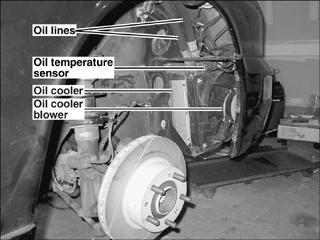
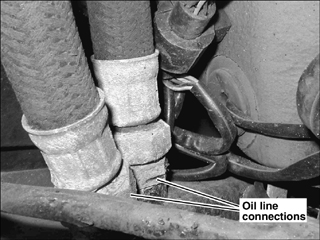
The oil cooler is connected to the oil thermostat and the oil tank in the rear of the car by two oil lines. These run to the back along the right side of the car.
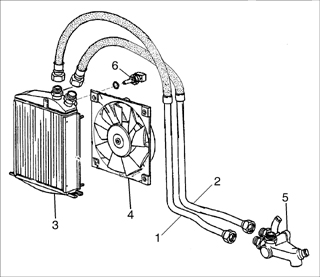 | ||||||||
|
Of the two solid oil lines from the thermostat to the oil cooler, the inside one (1) is the supply from the thermostat (hot), and the outside one (2) is the return to the oil tank. In the front fender, the hot line is also the inside one. This is not obvious when the cover at the bottom rear of the front wheel well is removed. The inside hot line is connected to the flexible line which goes to the front oil cooler connection. This is the more vertical one. The angled connector on the rear of the oil cooler is supplied with cooled oil from the bottom of the cooler.
Oil cooler thermostat
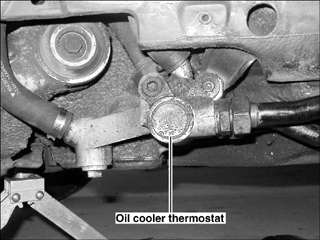
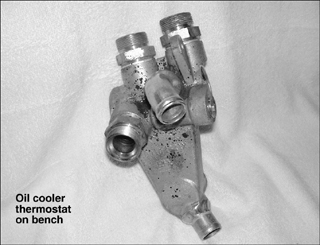
One oil line connects the oil cooler to the external oil tank. This is the return line. (There is a straight through connection for this pipe in the oil thermostat.)
The other oil line is connected to the engine via a thermostat, mounted to the right lower body structure forward of the external oil tank.
A bimetallic oil temperature sensor mechanically opens the thermostat at a specific oil temperature. Oil flow from the engine is then diverted to the oil cooler first before returning to the oil tank.
The specifications for the oil thermostat changed over the years. The 1989 to 1991 components are interchangeable, although it is always better to replace any part with a later version. Going backwards is not recommended. This particularly applies to 964 owners who use parts from wrecks.
| Oil cooler thermostat (Porsche part nos.) | ||
| ||
| ||
| ||
| ||
| ||
| ||
CAUTION — |
End of excerpt
©2002 Robert Bentley, Inc. We encourage visitors to link to this page if you’d like to share this information with others. Please do not copy this excerpt to other web sites. It is protected by copyright and represents significant resource investment by Bentley Publishers.
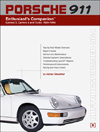
![[B] Bentley Publishers](http://assets1.bentleypublishers.com/images/bentley-logos/bp-banner-234x60-bookblue.jpg)
